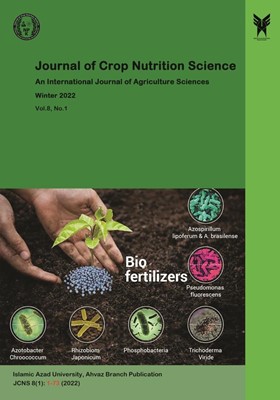Effect of Vinasse Application on Germination and Absorption of Some Macro Elements by Barley (Hordeum vulgare)
محورهای موضوعی : Journal of Crop Nutrition ScienceRamila Bezian 1 , Kamran Mohsenifar 2 , Ali Gholami 3
1 - MSc. Graduated, Department of Soil Science, Ahvaz Branch, Islamic Azad University, Ahvaz, Iran.
2 - Department of Soil Science, Ahvaz Branch, Islamic Azad University, Ahvaz, Iran
3 - Department of Agriculture, Shahinshahr Branch, Islamic Azad University, Shahinshahr, Iran.
کلید واژه: nitrogen, phosphorus, Potash, Forage, Yield</i>, <i>Cereal,
چکیده مقاله :
BACKGROUND: Vinasse, the effluent of ethanol alcohol factories, is one of the water sources that can be used well in agriculture. The management of this resource rich in nutrients is very important and necessary to supply plants with nutrients.OBJECTIVES: Current research investigated the effect of different levels of Vinasse on germination and absorption of nutrients nitrogen, phosphorus and calcium by barley.METHODS: In the present study, an experiment was conducted at two levels of 10% and 25% Vinasse and a control in experimental plots with a randomized complete block design with four replications. Vinasse treatments with irrigation water included the first treatment without the use of Vinasse, the second treatment including 90% water and 10% Vinasse, and the third treatment including 75% irrigation water and 25% Vinasse.RESULT: The results showed that the increase of Vinasse in the germination stage of the seeds was effective at the level of 1% and caused a decrease in the average daily germination and germination percentage. So that the highest daily germination with an average of 0.90 corresponds to the control treatment, i.e., 100% water, and the lowest daily germination with an average of 0.74 corresponds to the third treatment of 25% Vinasse. The highest and lowest germination percentages were obtained in the control treatment and the 25% Vinasse treatment, respectively 100% and 88%. The amount of absorbed food elements (nitrogen, phosphorus and potassium) in vegetative parts of barley plant was significant compared to the control. Adding Vinasse to the soil increased fodder yield, so that by adding 25% Vinasse, a significant difference was observed with the control, the amount of fodder increased from 5.87 in the control to 9.19 tons per hectare in the 25% Vinasse treatment.CONCLUSION: Adding Vinasse to the soil caused a significant increase in the amount of nitrogen, phosphorus and potassium absorbed in the vegetative parts of the barley plant at the level of 1%. Adding Vinasse to the soil increased fodder yield and barley grain yield. The results showed that due to the abundance of Vinasse in food, adding it to the soil can be recommended as an alternative to chemical fertilizers in the cultivation of plants such as barley with proper management.
Alinejadian Bidabadi, A., T. Jamili. and A. Maleki. 2021. Effect of Sugarcane vinasse on nutrient content and growth characteristics and yield of Basil (Ocimum basilicum L.). J. Vegetables Sci. 4(2): 1-14.
Amin, A. E.-E. A. Z. 2018. Amelioration of calcareous sandy soil productivity via incorporation between biochar and some organic manures. Arabian J. GeoSci. 11(23): 759.
Chen, L., M. Liu, A. Ali, Q. Zhou, S. Zhan, Y. Chen, X. Pan. and Y. Zeng. 2020. Effects of biochar on paddy soil fertility under different water management modes. J. Soil Sci. Plant Nutr. 20(4): 1810-1818.
Christofoletti, C. A., J. P. Escher, J. E. Correia, J. F. U. Marinho. and C. S. Fontanetti. 2013. Sugarcane vinasse: Environmental implications of its use. Waste Management. 33(12): 2752-2761.
Elgharbawy, A. 2021. A review on vinasse A by-product from sugarcane industry. Trends Petro Eng. 1(2): 1-3.
Fakhari, R., A. Tobeh. and A. Babaie. 2013. Investigating the relationship between electrical conductivity and germination in different cultivars of wheat seeds. The 13th Conf. Agri. Sci. Plant Breed. Iran and the 3rd Conf. Iranian Seed Sci. Tech. Iran.
Gee, G. W. and J. W. Bauder. 1986. Methods of soil analysis: Part I-Physical and Mineralogical Methods. Soil Sci. Soc. Am. American Soc. Agron.
JafariNaini, S. Z., A. Jafarnejadi, K. Mohsenifar, T. Babaeinejad. and A. Gholami. 2022. Application of vinasse and humic acid on soil potassium availability and Sugarcane yield in conditions of deficiency of macro-elements. Iranian J. Soil and Water Res. 53(3): 447-458.
Marcińczyk, M., Y. S. Ok. and P. Oleszczuk. 2022. From waste to fertilizer: Nutrient recovery from wastewater by pristine and engineered biochars. Chemosphere. 306: 135310.
Meyer, S., D. Fischer, A. Meyer, E. Karltun. and M. P. Silvén. 2022. Biochar-fertilizer blends-A valuable soil amendment for asparagus cultivation? J. Soil Sci. Plant Nutrition. 22(1): 691-705.
Pasqualin, L. A., J. A. Dionísio, M. A. C. Zawadneak. and C. T. Marçal. 2012. Edaphic macrofauna in sugar cane crops and forest in northwestern Paraná-Brazil. Semina: Ciências Agrárias. 33(1): 7-18.
Pinto, L. E., C. F. D. S. Cordeiro, A. S. De Araujo. and F. F. D. Araujo. 2022. Vinasse improves soil quality and increases the yields of soybean, maize, and pasture. Revista Brasileira de Engenharia Agrícola e Ambiental. 26: 335-340.
Premi, P. R. and A. H. Cornfield. 1969. Incubation study of nitrification of digested sewage sludge added to soil. Soil Biol. BioChem. 1(1): 1-4.
Regional Salinity, L. 1954. Diagnosis and improvement of saline and alkali soils. U.S. Dept. Agriculture.
Sadeghi, S. H., Z. Hazbavi. and M. K. Harchegani. 2016. Controllability of runoff and soil loss from small plots treated by vinasse-produced biochar. Sci. The Total Environment. 541: 483-490.
Sanchez-Lizarraga, A. L., V. Arenas-Montaño, E. N. Marino-Marmolejo, L. Dendooven, J. B. Velazquez-Fernandez, G. Davila-Vazquez, J. Rodriguez-Campos, L. Hernández-Cuevas. and S. M. Contreras-Ramos. 2018. Vinasse irrigation: effects on soil fertility and arbuscular mycorrhizal fungi population. J. Soils and Sediments. 18(11): 3256-3270.
Sheldon, A. R., R. C. Dalal, G. Kirchhof, P. M. Kopittke. and N. W. Menzies. 2017. The effect of salinity on plant-available water. Plant and Soil. 418(1): 477-491.
Sumner, M. E. and W. P. Miller. 1996. Cation exchange capacity and exchange coefficients. In: Methods of Soil Analysis (pp. 1201-1229).


